Author: erkan

The Sarcophagus of Mevlana Konya – Chapter 2
The Sarcophagus of Mevlana Konya – Chapter 2,
No nails were used, each part had been cut so accurately that they fit into each other perfectly. On the front was an inscription telling Mevlana’s identity, at the end of which were written these lines: “Those who visit this place of rest are happy. Here lies Mevlana, the sultan of scholars in both east and west, who shines in the darkness. illuminates the nights, the light of God, a priest the son of a priest, beloved of those who decorate the people’s gardens of the heart with true flowers, who distinguish right from wrong, the pivot of holy knowledge.” At the back is written the date of his death and the name of the artist who designed the sarcophagus. On the sides are inscribed some odes written by Mevlana and 22 couplets from his Mesnevi. Here is what Mevlana calls out in these lines:
When I die and you see my coffin carried on their shoulders, do not suppose that I carry the trouble of the world with me. Do not cry for me, do not say ‘what misfortune’, or ‘alias’, the time to thus lament is when you fall into Satan’s trap. When you see my corpse do not bewail the separation, my meeting, my finding begins then. When they put me in the grave do not say farewell. The grave is the curtain before heaven’s gate. You have seen the sunset, so watch it rise. The setting does not harm the sun or the moon. To you, it seems that they set, but in fact, it is a rebirth. The grave seems like a prison, but in fact, it releases the soul from prison.
What seed ever fell to the ground without growing. Why do you not believe that the seed of man will grow when it is sown.
You can continue to find more details about The Sarcophagus of Mevlana Konya in chapter 3.
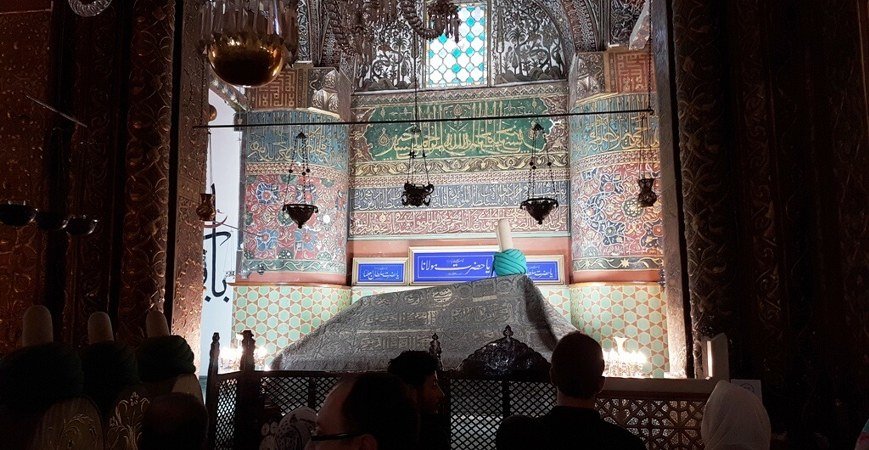
The Sarcophagus of Mevlana Konya – Chapter 1
The Sarcophagus of Mevlana Konya – Chapter 1,
The entire city of Konya mourned when on Sunday, December 17, 1273, as the sun set, the news came of the death of Mevlana, the great thinker, and mystic who was beloved by everyone. The following day with a great ceremony his body was taken to the sultan’s garden outside Konya Castle and buried at the side of his father. A few months after Mevlana’s death his son Sultan Veled with the help of some friends decided to construct a tomb over his father’s grave. Construction of the tomb began with a budget of ninety-two thousand drams. The architect was Tebrizli Bedreddin, a fine artist and a friend of Mevlana’s. The tomb was built in the shape of a dome of sixteen sections resting on four columns, and decorated on the outside with tiles and on the inside with painted designs. While the tomb was under construction an artist called Abdulvahid was designing a wooden sarcophagus to go over Mevlana’s grave. It had to be such a sarcophagus that the like had not been seen in the world before. The love and respect felt by Abdulvahid for Mevlana enhanced his skill to produce a work of unequaled beauty. The sarcophagus was to be made of burned walnut wood decorated with Seljuk designs and Odes from the Divan (collection of poetry) of Mevlana. At the head and foot would be written Mevlana’s name. The design was complete, all that remained was to have it constructed. Then a master carpenter called Genekoglu Humameddin Muhammed came and said that he would do it and his offer was accepted. A few months later the sarcophagus was complete. When all its parts were fitted together it was 2 m. 65 cm. long, 2 m. 13 cm. high and 1 m. 15cm. wide.
You can continue to find more details about The Sarcophagus of Mevlana Konya in chapter 2.
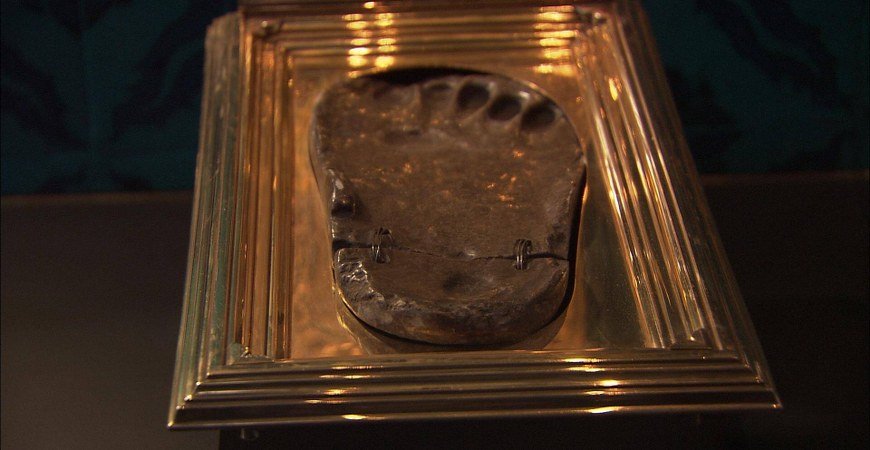
Topkapi Palace Museum Holy Relics Istanbul – Chapter 2
Topkapi Palace Museum Holy Relics Istanbul – Chapter 2,
Today the Hirka-i Saadet is kept in a box made of solid gold upon ‘which verses from the Koran are inscribed. This cloak is that which the Prophet Mohammad gave to the poet Kaab. Kaab had originally been against Mohammad, but later he repented and went secretly to Medina with a poem in praise of Mohammad which he had written, and found his way into the presence of the Prophet without revealing his identity:
— Mohammad! Kaab son of Zuheyr repents his doings. If he becomes a Moslem will you accept him? Upon receiving a positive reply he said:
— I am Kaab, and proceeded to read the poem which he had written. The Prophet was very pleased with the poem and taking off his cloak he presented it to Kaab. After Kaab’s death his heirs sold the cloak to the Emevi rules for twenty thousand drams of silver, and thus the cloak was passed first to the Emevis and then into the hands of the Abbasis. Now it is among the relics which Sultan Selim brought to Istanbul. Among the Holy Relics are the words of the Prophet, a letter parchment written by him called the ‘Name-i Saadet’, one of his seal made of cornelian stone, a piece of his tooth which broke during the battle of Uhud, the sacred banner of Mohammad, a hair from his beard, the swords of Ebubekir, Omer, Osman and Ali, a copy of the Koran written on gazelle skin which Osman was reading at his death, the footprint the Prophet in porphyry, the lock and keys of the Kaaba in Mecca, tv pieces from the cover of the Kaaba, a water pipe from the Kaaba, tt-cover of the Hacer’ul-esvet (the black stone in the Cubical House at Mecca, a gold light fitting decorated with precious stones, lamps, prayer carpet’ and many other valued objects. The Hirka-i Saadet Apartment has recently been renovated and opened to the public.

Topkapi Palace Museum Holy Relics Istanbul – Chapter 1
Topkapi Palace Museum Holy Relics Istanbul – Chapter 1,
The greatest treasures of Topkapi Palace are the Holy Relics. These relics, revered by the Islamic World, have a spiritual value that defies estimate according to material criteria. The boxes, cases, and cloths in which the Holy Relics are kept are each in themselves masterpieces. Some are made of gold, some of the silver, and they are decorated with diamonds, rubies, and emeralds, dazzling to the eye. The Holy Relics are kept in the Hirka-i Saadet section of Topkapi Palace, as they have been for centuries, and can be visited. It used to be called the Has (private) apartment and was one of the first buildings constructed by Sultan Mehmet the Conqueror. It is an architectural masterpiece with four domes, an exedra and decorated with tiles. It was originally used as a conference room during the time of the Conqueror and became the Hirka-i Saadet Apartment during the time of Yavuz Sultan Selim.
After conquering Egypt the Sultan was given the title of Caliph, and while preparing to return to Istanbul The Sherif of Mecca sent his son EBU Numey to Cairo to give the keys of Mecca and Medina and some of the relics to the Sultan. Yavuz was very pleased with this gesture of the Sherif of Mecca and issued an edict proclaiming that the Sherif should be left in his post. The Sultan returned to Istanbul with the relics and put them in the Has Apartment and the Topkapi Palace Treasury. Gradually a tradition grew up ‘whereby visits were made to the relics with special ceremonies. Because the Hirka-i Saadet (cloak) of the Prophet Mohammad ‘was among them, the rooms where the relics were kept was renamed after it.
You can continue to find more information about the Holy relics in Istanbul Topkapi Palace Museum in chapter 2.
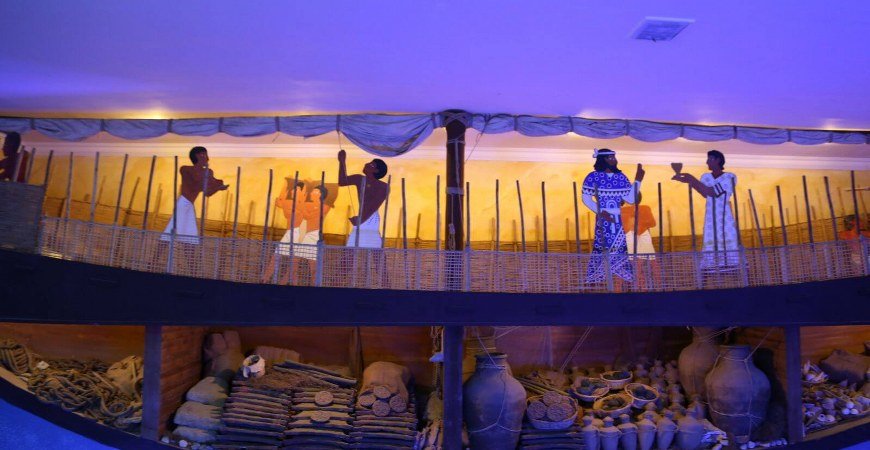
UNDERWATER WORKS IN BODRUM TURKEY
UNDERWATER WORKS IN BODRUM,
For many years sponge divers have collected sponges from the shores of the Aegean. It is a traditional trade by which they earn their living. Byways and means are known only to them, they dive to depths of forty fathoms and gather up raw sponges, which they then bring to shore and trample on to make usable. While searching for sponges they often come across the rotted hulk of an old wrecked ship and the scattered goods which it was carrying. In 1953 an experienced Marmaris sponge diver was swimming east of Bozburun near Kizilada when twenty fathoms below the surface on the sea bed he saw a rusty bronze object. With difficulty, he carried it to the surface and took it to Marmaris. It was an 81 cm. high statue of a woman. The statute was taken to Izmir Archaeological Museum, where it was patiently cleaned. It turned out to be an astonishingly beautiful work of art. The statue was cut off at the waist, perhaps being half of an originally full-length statue. Her breast and shoulders were covered with a fine cloth and her head also covered with cloth which fell to her shoulders. She had a soft smile which made her resemble the Mona Lisa in the Paris Louvre. Unfortunately the top of her head and right shoulder had rotted, but even so disfigured she lost none of her beauty. Archaeologists came to the conclusion that this was a statue of Demeter made in the Classical period during the fourth century BC. At that time Demeter had been the Goddess of Fertility in Anatolia, particular devotion and respect being accorded her in the coastal cities of Marmaris, Datca and Bodrum Turkey.
With the discovery of the statue of Demeter interest in the Aegean coast from Fenike to Bodrum increased. Sponge divers found amphoras, statues and other historical objects from the seas of this region, and they began to be gathered in the Museum of Underwater Works which was being established in Bodrum Castle at that time. However, the sponge divers without special equipment were despoiling the wrecks and doing more harm than good. It was immediately forbidden to search the wrecks, and in 1961 equipped with modern equipment systematic underwater exploration began near Bodrum Turkey, conducted by an underwater archaeological team led by Dr. George Bass professor of archaeology at Pennsylvania University. These productive searches are continuing today. Parts of ships, brass ingots which were used as money, pitchers, dishes, statues, stone anchors, steel yards, coins and all other findings were placed in the Bodrum Museum of Underwater Works which was opened to the public in 1964. This museum is one of the few museums of underwater findings in the world. The museum also contains works from the Mycenean civilization found in archaeological excavations. Searches are still going on and the findings enrichening the contents of the museum.
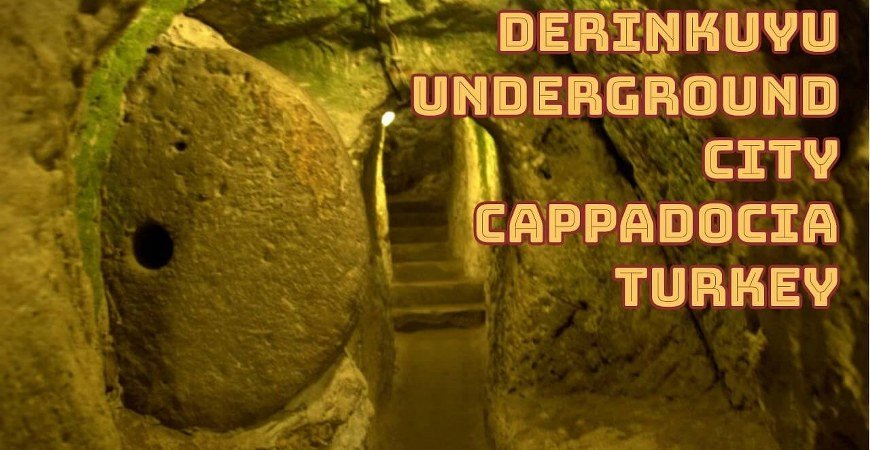
The Departure Of The Byzantines From Derinkuyu Area of Cappadocia
The Departure Of The Byzantines From Derinkuyu Area of Cappadocia,
The VI century A.D. saw the beginning of the Byzantine – Arab conflict during which time Derinkuyu and its vicinity were heavily attacked three times. After these attacks, many of the Byzantines living in this area found it increasingly difficult to continue living underground in hiding and evacuated Derinkuyu Underground City, which thus lost much of its earlier importance. The underground city was deserted for many years and fell into disrepair. Air ducts were blocked by earth and rocks swept into them by rain and the wind; many roofs in rooms and tunnels fell in.
After the seventh century, Christians were able to carry on the propagation of their religion openly; some of them carved hundreds of churches into the rocks and “fairy chimneys” in the Goreme and SoOanli region and used them as training centers for Christian missionaries.
After the XII century, Anatolia gradually came under the domination of the Seljuk Turks. The religious toleration shown by them gave an opportunity to the Christians in this area to add many frescoes to the churches at airtime, Ihlara and Soganli. In the XIV century, with the emergence of Ottoman power, some more of the Byzantines left the region and thus Goreme, lhlara and Soganli lost their early importance, though the natural beauty and artistic interest of the region are unsurpassed in the world.
The Churches On The Ground
Among the interesting sights of Derinkuyu, its churches rank high which is can be visited in Cappadocia Green Tour. These date back to the XVI and XVII centuries; one of them was converted into a mosque in 1949 and still has painted on its dome remarkably well-preserved frescoes of the Angels, the Virgin Mary, Christ and his Apostles. Frescoes of the second church are partially damaged, but the carvings at the entrance and the revolving cylindrical columns (in order to check the stability of the building) are worth noting. Also, the elegant belfry is interesting. The mostly unexplored underground cities of Ayan, Goble, Suvermez, Dogala, Cakilli, Zelve, Orentepe, Kakale, (all in the Derinkuyu region) and the ruins of an early caravanserai are proof that this region was for many centuries a centre of civilization; examples of man’s ingenuity and skill are still here for us to see.
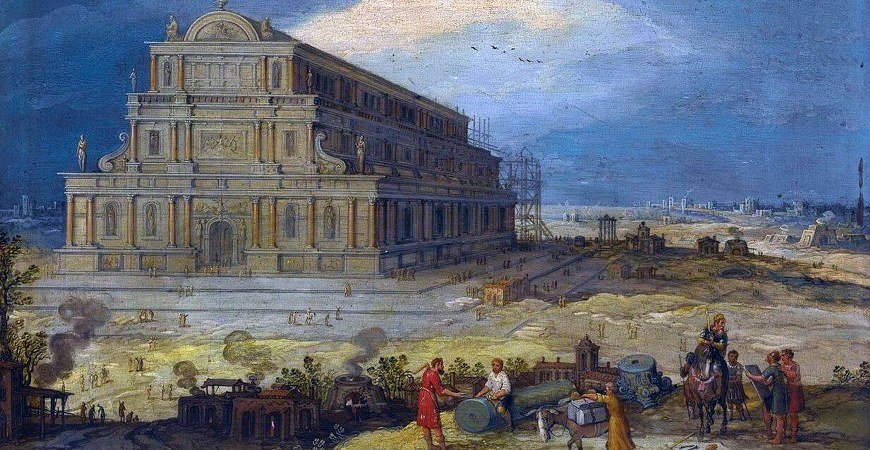
The Temple of Artemis Ephesus Turkey
The Temple of Artemis Ephesus Izmir Turkey
One day the hero of legend Agamemnon set out for Troy with his navy and army. On the way, he entered a harbor and went out hunting. When Agamemnon killed the sacred deer of Artemis the goddess got her revenge by stopping the winds which would allow the ships to leave the harbor, and Agamemnon was forced to stay. The diviners said that if he sacrificed his daughter Iphigenia it would appease the anger of Artemis. This put Agamemnon in a difficult spot but in the end, he decided to send his daughter to the temple to be sacrificed. But just as the priest raised up his knife Artemis turned Agamemnon’s daughter into a deer and the girl was saved. A short while later a sea wind began to blow. Temples dedicated to Artemis were built in several places, and statues of the goddess with a bow in her hand and a beer by her side placed in them. The marble statue of Artemis found on the site of the municipal building in 1955 which was original that belonging to the large Artemis temple in Ephesus is something of a mystery. Archaeologists say that it was made in the second century BC yet it is very different from other Artemis statues that are in various other museums of the world. Once you join our Ephesus Tours, you will be able to visit Tample of Artemis and get deep information about it.
It is very beautiful and as soon as it was discovered it was taken to Ephesus Museum. Art historians and experts from all over the world came rushing to Ephesus to see the statue, and in a short time it came to be known as ‘Beautiful Artemis’.
The Ephesus Artemis or Beautiful Artemis depicts the goddess clothed and standing, with a crown on her head. She appears to be leaning against a cushion decorated with the figures of sacred animals. Her expression is a sweet seriousness with drawn eyebrows s, almond eyes, and full lips. She is wearing a necklace. Her breast is covered with three rows of egg shaped symbols representing abundance, and her skirts carry the figures of sacred animals. She holds two staffs in her hand and there is a deer on either side of her. Such a beautiful Artemis deserves her name. She is certainly different from the Artemis statues in the west. She is clear;y inspired by the Mother Goddess Cybele who was worshiped in Anatolia for thousands of years. In fact, experts say that the worship of Artemis was a continuation of the traditional Mother Goddess cult of Anatolia. On her skirts are the Bee symbols of the city of Ephesus. During this period every city had its symbol that of Ephesus being the honey bee. If you ever travel to the sub-province of Selcuk from Izmir and visit the ruins of Ephesus you should not leave without visiting the Ephesus Museum. At the entrance to the museum, you will be greeted by a magnificent lady with long skirts of milk white marble.

Artemis Temple Ephesus Turkey – Chapter 1
Artemis Temple Ephesus Turkey – Chapter 1,
The Temple of Artemis at Ephesus was one of the famed seven wonders of the world. Historians say that the temple, of which today only the foundations remain, was rebuilt at least four times in antiquity. The fourth temple which was built by the famous Lydian King Croesus, was set on fire by a madman on the eve of Alexander’s birthday on July 21, 355 When Alexander the Great visited Ephesus at the start of his march through Asia and learned that the temple had been burned down on the night of his birthday he asked that it be rebuilt and offered to pay all of the building expenses only stipulating that his name be inscribed on the new temple.
This proposal was not well received by the people of Ephesus: Our temple is dedicated to the Goddess Artemis. We recognize you as a God but it is not seemly to have one temple dedicated to two gods, they said politely and set about collecting money among themselves in order to finance its construction for the fifth time. This new temple was the largest and most beautiful temple which had ever been constructed in the world. All the treasure of Ephesus was hidden there. As a result, it was pillaged time after time, and after the Christian Byzantines had finished with it and the Romans before them it was in ruins. Its remains were used to construct new buildings, and it is said that some of the columns of the temple were carried to Istanbul and incorporated into the construction of the church of Saint Sophia. Because the people of Ephesus had chosen Artemis as their protector they had a large scale statue of her made which was placed in the temple.
Artemis was the daughter of Zeus and Leto according to myth and the twin sister of Apollo. She, Hike Apollo, carried a bow and gold arrows, and the land and sea would shake when she shot one of her gold arrows. This beautiful goddess symbolized skill and was the protector of wild animals, virgin girls, children, and shepherds.
Please check more details about the Temple of Artemis Ephesus in Turkey on More Information about Artemis
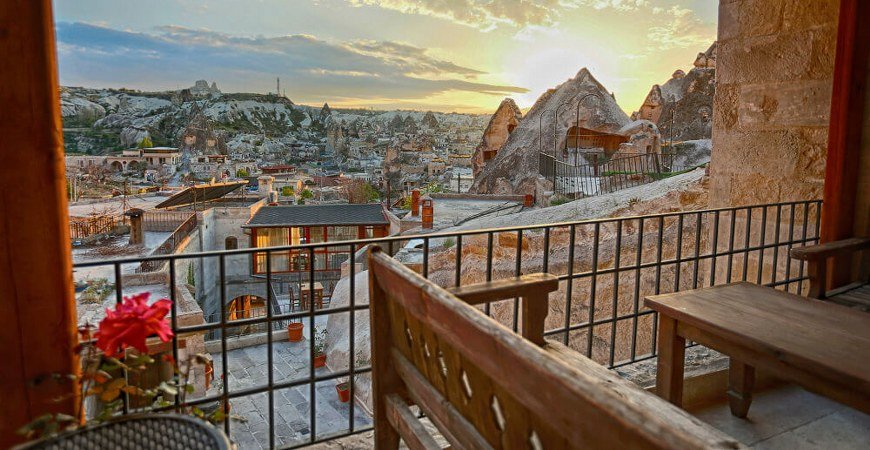
Cappadocia Cave City Turkey
Cappadocia Cave City Turkey,
Goreme (Avcilar)
Avcilar is a town located 500 meters west of Goreme rock churches and laid in Goreme Valley, embraced by natural beauties and ancient ruins. This location with an area of approximately 5 sq.m. is decorated with attractive fairy chimneys rock cavities and iconoclastic churches. Inhabitants of this locality live alongside such magnificent fairy chimneys and rock cavities. They sometimes protect themselves against cold winter and hot summer conditions by adding rooms to certain cavities to live in. Such rooms are warm in winter and cool, in summer. Some of those are today serving as pensions for tourism purposes. One should overlook from vineyards located 2 km west of town from Ughisar Castle in order to see fairy chimneys and vast beauties in Cappadocia. The people in Avcilar (Goreme) are well conscious of the importance of tourism and consider it a task to render services in that respect. They offer both to local and foreign tourist the traditional Turkish hospitality with hotels, motels, campings and pensions built within their own capabilities in the region.
Ortahisar
Ortahisar is a pretty township of Urgup, situated one km. to the south of the Nevwhir-Kayseri highway. Its main attraction is a marvelous fort, similar to the one in Ughisar. From this fort, both foreign and local tourists have a magnificent view of the Goreme Valley. Such fortresses were used in Christian times as centers of communication as well as places of refuge.
The village also possesses hundreds of storage places for lemons; some of them are still in use after being restored. So efficient is their ventilation system that lemons may be kept in them for a whole year. Carpet-Weaving, vine-pressing are the other major occupation of natives. The frescoes of “Uzumlu Kilise” (Church with Grapes) indicate that this was a vine-growing district also in ancient times.